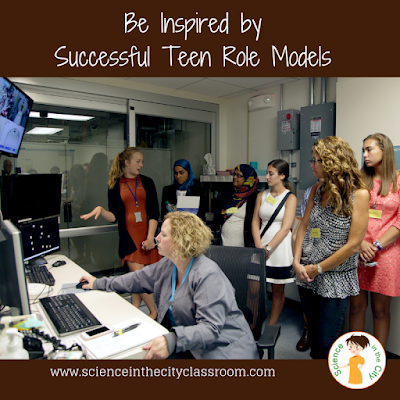Be Inspired by Successful Teen Role Models
For students whose parents are engineers, scientists, or who have friends or family friends in these roles, it is easier to picture themselves in that role. When students have good role models of scientists, problems solvers, and engineers as a part of their daily life, they see that as a path they can follow to do the same. When most people you know have gone to college, you also assume that you will go on to college.

But what about those students who don’t have those role models in their everyday lives?
Many of our students are from a poorer demographic, don’t have friends and family who are very educated, don’t speak the dominant language etcetera, and may have a more difficult seeing themselves in this role. As they grow up they may not even think that being an engineers, scientists, or other type of educated professional, having a patent, or being a ‘leader’ in this sense is an option or a possibility for them.How do we fix this problem?
As teachers, I believe that part of our role in education is to show students examples of people similar to them who have been successful as engineers and scientists, even through non-traditional paths. Several scientific inventions have been made through hard work on a different path, or even through an accidental discovery that led to a greater invention.Sometimes this can be through being that role model, as outlined in this article. It also helps build connections. The author states that “Students can sense that I understand their experiences, that I’m rooting for them, and that success in whatever field they choose is within their grasp.” There are several articles, such as this one, and this one that emphasize this idea of students benefiting from having teachers whose background is more similar to their own.
What if we are not from a minority group?
If this is not our personal story, however, we can help present students with success stories, even if they are not our personal story. I don’t believe it is only minority teachers who can help bring this benefit to a classroom of minority students. It has been shown that “Good Teachers Embrace Their Students’ Cultural Background.” In fact, in a study of high achieving urban environments, some of the deciding factors were the “development of a belief in self, supportive adults, interaction with a network of high-achieving peers, extracurricular activities, challenging classes such as honors classes, personal characteristics such as motivation and resilience, and family support” as cited in this article. As teachers, we can help support these skills and qualities. When we bring examples of pictures of scientists into class, it is critically important that they look like our students. This idea is further explored in this article, the authors state that reading acts as both a window and a mirror…. “mirrors in that they can reflect on children’s own lives, and windows in that they can give children a chance to learn about someone else’s life.” Additionally, “while it may be ideal for children to actually meet people from different backgrounds [or from a similar background, but with a different ending] in person, if that isn’t possible, books can serve as a first introduction to an outside world.” The article does a great job of explaining the importance of introducing students to these examples. This is the idea behind the book Wonder Woman, by Sam Maggs, explored in this article “Why it’s so important for girls to find role models in female scientists.”
This is all a part of being a teacher too. We need to help students see that science is more than the type of science in the textbook for which they are graded and tested, and that it is something accessible to them. We can do this by showing them examples. As you bring in famous scientists to talk about in class, new articles to use, or other examples in class, make an effort to showcase people of various backgrounds. It adds value to both the students, and to the class as a whole! Some great examples are William Kamkwamba, Deepika Kurup, and Trisha Prabu, but there are many more out there! Utilize them in your class with your students! See how they react!
This is all a part of being a teacher too. We need to help students see that science is more than the type of science in the textbook for which they are graded and tested, and that it is something accessible to them. We can do this by showing them examples. As you bring in famous scientists to talk about in class, new articles to use, or other examples in class, make an effort to showcase people of various backgrounds. It adds value to both the students, and to the class as a whole! Some great examples are William Kamkwamba, Deepika Kurup, and Trisha Prabu, but there are many more out there! Utilize them in your class with your students! See how they react!





No comments :
Post a Comment